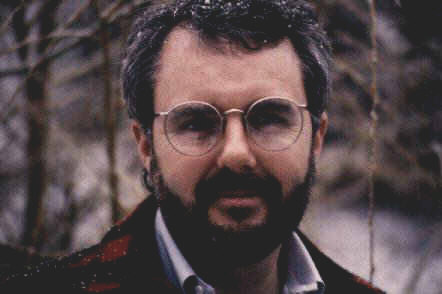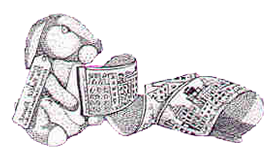
Ed Hutchins
Poetry Behind the Scenes
Interview with Ed Hutchins by Kara L.C. Jones
Q: What is artistbooks.com?
Ed: It is a website for the artist books of Editions. I consider it a scrapbook where we can store and share some of the information and experiences we’ve accumulated over the years. The web site is constantly changing. At the moment there is a new Flexagon Funhouse where you can click on different models to see how they operate and take a virtual tour of Taller Lenateros, the paper and book cooperative in Chiapas, Mexico. As anyone with a website knows, it takes a terrific amount of time to keep the information current and operating as desired. Our site would not be possible without the efforts of my spouse, Steve Warren.
Q: Your philosophy of Guerrilla Bookmaking has fascinated me and given me language to talk about what I do when I teach bookmaking. Can you say a bit about what Guerrilla Bookmaking means to you? How did you come to call yourself a Guerrilla Bookmaker?
Ed: Guerrilla Bookmaking is a reaction to the common perception that the crafts of book arts—papermaking, letterpress printing and binding—require a lot of skill, a lengthy period of training, supervision, and a finished product that meets certain expectations. In fact, it is possible for someone with much to say to present their ideas in respectable book formats that use simple skills and are created with materials found close at hand.
Q: Can you talk a bit about your work with teachers and parents? Are you available to teach workshops for teachers and parents? How would they contact you if they wanted you to help them learn about Guerrilla Bookmaking?
Ed: I have a love/hate relationship with workshops. Since I work alone, it’s always a treat to have a break from the studio. Regardless of whether I work with adults or children I always marvel at the work they produce. However, at the same time there is so much to be done in the studio that I begrudge the time away. In the end, I teach three or four classes a year. Equally important, I also take two or three classes a year.
Q: Do you consider yourself a writer first or a bookmaker first? Or do you feel it all works together? How did you discover your love for writing and bookmaking?
Ed: I consider myself to be a book artist. A better question at this point would be, What makes for a great book? I think that a great book is when the paper, the printing, the text, the illustrations, the concept, the binding, and the cover all come together to seamlessly deliver the message in a book format. Because all of these are important and independent, it doesn’t matter where you start. Maybe it’s a conversation overheard on the bus, maybe it’s the shape of a cloud in the sky, or maybe it’s a sheet of lime green velour paper that strikes your interest. Wherever you start, as a writer or bookbinder, you need to include the other book components in a relevant way to finish up with a terrific book.
Q: What is your favorite part of bookmaking? What is your least favorite part? I’m asking about everything from idea to manifestation to promotion and actual sale of books.
Ed: I like most parts of bookmaking. I love fleshing out ideas, figuring the production plan, scouting out and rounding up the necessary materials, and working through the production–especially any sewing that needs to be done. I love seeing the finished books start to pile up. If one book looks great, then imagine the thrill of seeing a dozen, and then two dozen books all in a row. And I like doing shows when I get to put my books in collectors’ hands and observe how they relate to my books. They only parts I don’t enjoy are working on leaderless committees, chatting for long periods of time at an opening, and giving interviews where I can’t think before giving answers (I always end up saying something stupid!).
Q: The visual gallery at artistbooks.com is just amazing! Do you find it difficult to part with the books after you’ve made them? Do you ever make just one extra in a run to keep or do the photo work as your portfolio?
Ed: You’ve hit on the best reason for creating editions: it allows you to sell some, exchange a few with other artists, hold some back for your retirement, share a couple with friends, AND still have one copy left just for yourself. At one point I only made unique books and I had good success selling them. Over the years I’ve been able to buy back all of them but one. It has a happy home, but I still miss not having it around. Since the nature of a unique book is that it accomplishes unique things, I still make them and like to keep them in the studio to show to students what they can accomplish.
Q: How did you learn the business of your art? Did you have mentors?
Ed: My first introduction to making books was by reading and following Pauline Johnson’s, Creative Bookbinding about 40 years ago. It’s still a good introduction, though she says it’s OK to use rubber cement, which is a very BAD idea. About 20 years ago I started taking classes at the Center for Book Arts in New York City, mostly with Barbara Mauriello. I identified the people making books that I most admired, Hedi Kyle, Keith Smith, Scott McCarney and Julie Chen, and I took classes from them, even if it meant traveling a good distance to do so. These talented bookmakers became my mentors when I was getting started. Now my mentors are my students. They are the ones who teach me the most.
Q: Do you like to work alone or in partnership with other bookmakers?
Ed: I generally work alone because it is very hard for two busy book artists to carve out time to work together. It is even harder when the artists live on opposite sides of the country. But it is possible, and the experiences that I have had have all been productive. I recently worked with Joe D’Ambrosio to bring out the February issue of Artists’ Book Reviews and Roberta Lavadour and I may do something together when I am in Oregon in April.
Q: What are your favorite bookmaking materials? Have you found materials that are too difficult with which to work?
Ed: My favorite bookmaking materials are the ones that find me, like the bobbing head turtles from Oaxaca, tiny pewter models of the World Trade Center, or Alberto’s handmade banana fiber paper. More than materials, it is misspelled words that give me the greatest aggravation. How is it possible that so many people (and a computer with Spell Check) can review a manuscript and misspellings STILL crop up?
Q: When you started your bookmaking, what was your vision?
Ed: I don’t recall having a lot of vision; I just wanted to make books. At the time it seemed like every new book was going in a different direction. Even today I have a lot of interests and it is hard to generalize my books. A new book may result from a technique I want to explore, an unusual material that strikes my fancy, or an idea I want to share. In the end, I’m very conscious of my audience and I recognize that a word to the wise is not sufficient if they don’t understand it. So I want my books to be comprehensible and I want them to be well constructed.
Q: Do you consider the crafts of writing and bookmaking to be healing arts for yourself? If so, how?
Ed: I don’t go much for metaphysical stuff, but I will say that in 1989 when I couldn’t answer the phone because of incessant calls from bill collectors and the bank that was in the process of re-possessing my home, I closed myself off in my studio making books. It was the one thing that kept me from going crazy. I figured that anything that could give so much pleasure in the midst of so much depression had to be worth devoting a life to. I’ve always been sustained by the satisfaction that comes from producing a well-crafted book.
Q: Where do you feel you are in your career today? Does it correspond to that initial vision if you had one?
Ed: With work that I love, a comfortable home and a devoted spouse, I am very happy. When I started the goal was to make book; nothing else mattered. Now I’ve learned that you can make books and have a family life at the same time. Who knew
Q: What do you see for artistbooks.com and Guerrilla Bookmaking in say 5 years or 10 or 20?
Ed: In five years It would give me a lot of pleasure if artistbooks.com and Guerrilla Bookmaking were taken over by younger, energized artists. They can have my research library, most of my records, supplies and equipment as well. I’m winding down and it would be great to see a new group take over producing new ideas.
Q: For those just discovering bookmaking, what would you tell them?
Ed: The first thing I would say is, Welcome to an exciting, creative and satisfying adventure. Never stop learning. Every year I take workshops and work with students to hone my bookmaking skills. It is a never ending, but always rewarding, process. You will save yourself a lot of time and aggravation if you always make a model of what you want to accomplish first. In time you will learn that the best ideas are the simplest ones.
